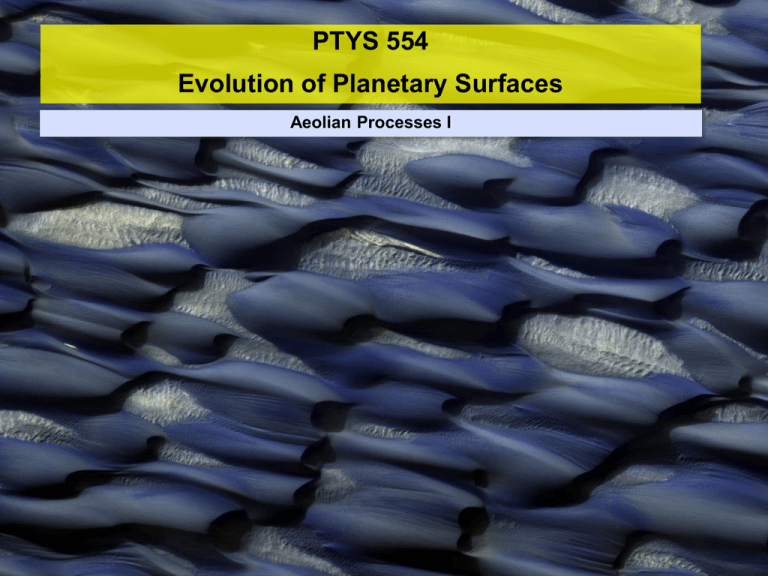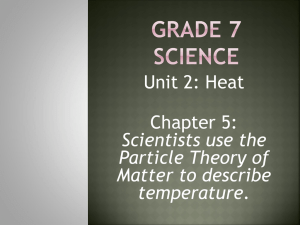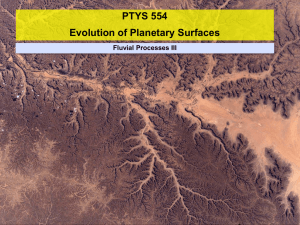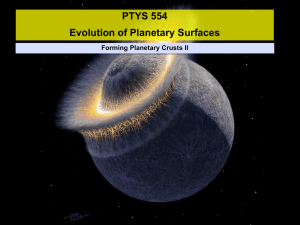PYTS 554 – Aeolian Processes I
advertisement

PTYS 554 Evolution of Planetary Surfaces Aeolian Processes I PYTS 554 – Aeolian Processes I Aeolian Processes I Entrainment of particles – settling timescales Threshold friction speeds Suspension vs. saltation vs. reptation vs. creep Dependences on gravity, densities of particle/air Aeolian Processes II Migration rates Dune types Dunefield pattern formation Ripples vs. dunes Ventifact, yardang erosion Dust-devils and wind streaks 2 PYTS 554 – Aeolian Processes I Suspension vs saltation 3 PYTS 554 – Aeolian Processes I 4 Suspension s inertial ra v 2 Re = = s viscous h (v d ) All particles eventually settle out of a quiescent atmosphere Reynolds number quantifies whether an atmosphere is quiescent Re > 10s means turbulent flow (viscosity doesn’t damp eddies) High velocity flows are more turbulent Low viscosity fluids are more turbulent Consider laminar flow around a falling sphere Drag from sphere affects air within a cylinder ~2d wide Downward force from weight – buoyancy Fdown = p 6 d 3 ( rs - ra ) g Fup = 3pd h(v d) 2 Equating the two gives the terminal velocity 1 d ( rs - ra ) g 18 h 2 v settle = ra v d h 3d Upward force from viscous drag Stress ~ viscosity x strain rate Area affected is curved wall of cylinder …and ignoring some numerical factors Re = Stokes’ law ra d d rs v PYTS 554 – Aeolian Processes I Low pressure Turbulent flow As before downward force from weight – buoyancy Fdown = p 6 d 3 ( rs - ra ) g Falling particle is opposed by ram pressure Fup = 5 p 4 d 2 ra v 2 Equating these to find the settling velocity – not very sensitive to particle size v settle 2 æ rs - ra ö = ç ÷gd 3 è ra ø d rs High pressure v ra PYTS 554 – Aeolian Processes I Turbulent eddies have speeds ~0.2 the mean windspeed For suspension: v settle £ 15 u For dust sized particles: Mars, Venus and Titan are effective at suspending particles …but Venus (and Titan?) probably doesn’t have high near-surface winds 6 PYTS 554 – Aeolian Processes I In a planetary boundary layer Drag of wind on surface produces a shear stress Measured with drag plates We define a ‘shear velocity’ u* Just another way to quantify the shear stress u* = t = ra u 2 t ra ¶u t =h ¶z For a Newtonian fluid (like air): In a thin laminar sub-layer η is constant and a property of the fluid (and temperature) u= t z h u z µ u* d where d » 5 h rau* Above this layer, turbulence dominates, η is a property of the flow and varies with height and u Empirically – law of the wall… (κ is Von Karman’s constant ~ 0.41) æzö u 1 = k lnç ÷ u* è zo ø 7 PYTS 554 – Aeolian Processes I Z0 is the equivalent roughness height 1/30th of the grain size for quiescent situations Otherwise it’s empirically determined from several wind measurements at different heights Greeley, 1985 8 PYTS 554 – Aeolian Processes I 9 Two regimes æzö u 1 = k lnç ÷ u* è zo ø Transition at: D ~ 0.7 δ Neither approach works well in the transition zone uµ z d where d ~ 5 h rau* Anderson and Anderson 2010 Small particles hide within the laminar zone, larger particles stick up into the turbulent zone Balance shear stresses with weight – buoyancy of particles Fdown = p 6 d 3 ( rs - ra ) g Fdrag = p 4 d 2 ra u*2 At the threshold velocity, some component of drag force balances the particle weight æ r - ra ö u*T = A ç s ÷gd r è ø a or t T = A2 éë( rs - ra ) gd ùû A2 often called θ A~0.1 PYTS 554 – Aeolian Processes I More detailed, gets you within a factor of 2 of deriving A t T = A éë( rs - ra ) gd ùû 2 Anderson and Anderson 2010 10 PYTS 554 – Aeolian Processes I Define the frictional Reynolds number A varies with this value -n A µRe* Re* = 11 ra u* d h where n >>>1 æ r - ra ö u*T = A ç s ÷gd r è ø a Recall: A Turbulent zone: A @ 0.1 ~3.5 Small particles in laminar zone Laminar zone: Re* u*T µ d -n u*T µ d uT u*T µ d -1 2 u*T µ ( u*T d ) d u*T µ d Large particles in turbulent zone 1 1 2 1 2-n n+1 -1 for big n u*T µ d ? d 1 2 PYTS 554 – Aeolian Processes I 12 ‘A’ should be constant in the fully-turbulent case Instead is depends on the fluid/particle density ratio A cautionary tale in using ‘dimensionless’ scaling from one planet to another… Basalt on Venus Quartz in water Ice on Titan Quartz on Earth Iversen et al.1987 Basalt on Mars PYTS 554 – Aeolian Processes I 13 Minimum exists when Re ~ 3.5 Re* = uT uT µ d -1 uT µ d 1 2 æ rs - ra ö u*T = A ç ÷gd è ra ø u* = u*T ? d ra u* d h 3.5 = & d = dmin at Re = 3.5 æ r - ra ö ra dmin A ç s ÷ gdmin h è ra ø 2 Easiest particles to move depends on 1 æ 3.5 ö 3 dmin = ç ÷ éëh 2 ( r s - ra ) ra gùû 3 è Aø ~225 microns for Earth Atm. viscosity Atm. density Particle weight (density and gravity) Buoyancy effects minor (until we get to the fluvial processes lectures) PYTS 554 – Aeolian Processes I Saltation threshold increases with particle size Particles classified by Udden-Wentworth scale 14 D 2 m m Easiest particles to move are sand-sized Dust Sand-sized 0.1 mm 1mm Gravel 1cm Greeley, 1985 PYTS 554 – Aeolian Processes I Necessary wind speed depends on atmospheric density 15 PYTS 554 – Aeolian Processes I Easy to move but not easy to suspend Particles are launched off the surface, but re-impact a short time later – saltation! Greeley, 1985 16 PYTS 554 – Aeolian Processes I Grains travel by saltation 17 Impacting grains can dislodge new particles (reptation) Impacting grains can push larger particles (creep) Impacting grains knock finer particles into suspension Impact vs fluid threshold It’s easier to keep saltation going than start it Impact threshold is ~0.8 times the fluid threshold for Earth …but ~0.1 times the fluid threshold for Mars This is what makes martian saltation possible Kok, 2010 Kansas State University PYTS 554 – Aeolian Processes I 18 Saltation length scales ~cm Greeley, 1985 PYTS 554 – Aeolian Processes I 19 Bagnold’s description of momentum loss Mass flux per unit length – q Momentum change of grains mass x (u2-u1) over a distance L, with u2>>u1 Stress is: t =q u -u L »qu L ( 2 1) Avg. horizontal velocity ~ 0.5 u2 Time of flight is 2w 1/g L = u2 w1/g w1 v2 so: u2/L = g/w1 t » q g w1 L Stress is also t = ra u* And w1 ~ u* (ignoring factors ~1) 2 r a u* 2 » q g w1 ra 3 q» q» g ra g u* u* 3 C d do u1 2 v1 Sand flux per unit length is proportional to shear velocity cubed Bagnold’s experimental work showed particle size is also a factor v1 PYTS 554 – Aeolian Processes I There are many variations fit to empirical data Greeley, 1985 20 PYTS 554 – Aeolian Processes I Titan 95% Dune Potential (All else being equal) Zero Zero Venus Zero 5% methane Density Kg m-3 71.92 1.27 0.027 5.3 Gravity (m s-2) 8.9 9.8 3.7 1.35 Dune material Basalt Quartz Basalt Organics (lower density) Titan Earth Mars 21 PYTS 554 – Aeolian Processes I As usual – all else is not equal Venus has very few dunes (two fields known) Lack of weathering into small particles Detectability of dunes ? Low surface winds 22 Dune Potential (All else being equal) Venus Titan Earth Fortuna-Meshkenet field Weitz et al. 1994 Mars has extensive dunefields Very high wind speeds Lots of active weathering breaking up rocks Mars PYTS 554 – Aeolian Processes I Aeolian Processes I Entrainment of particles – settling timescales Threshold friction speeds Suspension vs. saltation vs. reptation vs. creep Dependences on gravity, densities of particle/air Aeolian Processes II Migration rates Dune types Dunefield pattern formation Ripples vs. dunes Ventifact, yardang erosion Dust-devils and wind streaks 23









